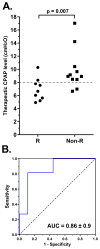Response to a combination of oxygen and a hypnotic as treatment for obstructive sleep apnoea is predicted by a patient's therapeutic CPAP requirement
- PMID: 28409851
- PMCID: PMC5511065
- DOI: 10.1111/resp.13044
Response to a combination of oxygen and a hypnotic as treatment for obstructive sleep apnoea is predicted by a patient's therapeutic CPAP requirement
Abstract
Background and objective: Upper airway collapsibility predicts the response to several non-continuous positive airway pressure (CPAP) interventions for obstructive sleep apnoea (OSA). Measures of upper airway collapsibility cannot be easily performed in a clinical context; however, a patient's therapeutic CPAP requirement may serve as a surrogate measure of collapsibility. The present work aimed to compare the predictive use of CPAP level with detailed physiological measures of collapsibility.
Methods: Therapeutic CPAP levels and gold-standard pharyngeal collapsibility measures (passive pharyngeal critical closing pressure (Pcrit ) and ventilation at CPAP level of 0 cmH2 O (Vpassive )) were retrospectively analysed from a randomized controlled trial (n = 20) comparing the combination of oxygen and eszopiclone (treatment) versus placebo/air control. Responders (9/20) to treatment were defined as those who exhibited a 50% reduction in apnoea/hypopnoea index (AHI) plus an AHI<15 events/h on-therapy.
Results: Responders to treatment had a lower therapeutic CPAP requirement compared with non-responders (6.6 (5.4-8.1) cmH2 O vs 8.9 (8.4-10.4) cmH2 O, P = 0.007), consistent with their reduced collapsibility (lower Pcrit , P = 0.017, higher Vpassive P = 0.025). Therapeutic CPAP level provided the highest predictive accuracy for differentiating responders from non-responders (area under the curve (AUC) = 0.86 ± 0.9, 95% CI: 0.68-1.00, P = 0.007). However, both Pcrit (AUC = 0.83 ± 0.11, 95% CI: 0.62-1.00, P = 0.017) and Vpassive (AUC = 0.77 ± 0.12, 95% CI: 0.53-1.00, P = 0.44) performed well, and the difference in AUC for these three metrics was not statistically different. A therapeutic CPAP level ≤8 cmH2 O provided 78% sensitivity and 82% specificity (positive predictive value = 78%, negative predictive value = 82%) for predicting a response to these therapies.
Conclusion: Therapeutic CPAP requirement, as a surrogate measure of pharyngeal collapsibility, predicts the response to non-anatomical therapy (oxygen and eszopiclone) for OSA.
Trial registration: ClinicalTrials.gov NCT01633827.
Keywords: continuous positive airway pressure; obstructive sleep apnoea; personalized medicine; phenotyping; upper airway collapsibility.
© 2017 Asian Pacific Society of Respirology.
Figures

Comment in
-
Will the safe-breakers of sleep apnoea find the right combination?Respirology. 2017 Aug;22(6):1059-1060. doi: 10.1111/resp.13069. Epub 2017 May 10. Respirology. 2017. PMID: 28488796 No abstract available.
Similar articles
-
Therapeutic CPAP Level Predicts Upper Airway Collapsibility in Patients With Obstructive Sleep Apnea.Sleep. 2017 Jun 1;40(6):zsx056. doi: 10.1093/sleep/zsx056. Sleep. 2017. PMID: 28419320 Free PMC article.
-
The Combination of Supplemental Oxygen and a Hypnotic Markedly Improves Obstructive Sleep Apnea in Patients with a Mild to Moderate Upper Airway Collapsibility.Sleep. 2016 Nov 1;39(11):1973-1983. doi: 10.5665/sleep.6226. Sleep. 2016. PMID: 27634790 Free PMC article. Clinical Trial.
-
Structure and severity of pharyngeal obstruction determine oral appliance efficacy in sleep apnoea.J Physiol. 2019 Nov;597(22):5399-5410. doi: 10.1113/JP278164. Epub 2019 Oct 1. J Physiol. 2019. PMID: 31503323 Free PMC article.
-
Optimal treatment of obstructive sleep apnea and excessive sleepiness.Adv Ther. 2009 Mar;26(3):295-312. doi: 10.1007/s12325-009-0016-7. Epub 2009 Apr 3. Adv Ther. 2009. PMID: 19337706 Review.
-
[Obstructive sleep apnoea].Ned Tijdschr Geneeskd. 2019 May 3;163:D3399. Ned Tijdschr Geneeskd. 2019. PMID: 31120225 Review. Dutch.
Cited by
-
More Than the Sum of the Respiratory Events: Personalized Medicine Approaches for Obstructive Sleep Apnea.Am J Respir Crit Care Med. 2019 Sep 15;200(6):691-703. doi: 10.1164/rccm.201901-0014TR. Am J Respir Crit Care Med. 2019. PMID: 31022356 Free PMC article. Review.
-
Post-Stroke Sleep-Disordered Breathing-Pathophysiology and Therapy Options.Front Surg. 2018 Feb 26;5:9. doi: 10.3389/fsurg.2018.00009. eCollection 2018. Front Surg. 2018. PMID: 29536012 Free PMC article. Review.
-
Oxygen for the treatment of obstructive sleep apnoea hypopnoea syndrome.Breathe (Sheff). 2019 Sep;15(3):e104-e107. doi: 10.1183/20734735.0206-2019. Breathe (Sheff). 2019. PMID: 31777572 Free PMC article.
-
Precision Medicine for Obstructive Sleep Apnea.Sleep Med Clin. 2019 Sep;14(3):391-398. doi: 10.1016/j.jsmc.2019.05.005. Epub 2019 Jul 4. Sleep Med Clin. 2019. PMID: 31375207 Free PMC article. Review.
-
Pathogenesis of obstructive sleep apnea in individuals with the COPD + OSA Overlap syndrome versus OSA alone.Physiol Rep. 2020 Feb;8(3):e14371. doi: 10.14814/phy2.14371. Physiol Rep. 2020. PMID: 32061194 Free PMC article.
References
-
- Gleadhill IC, Schwartz AR, Schubert N, Wise RA, Permutt S, Smith PL. Upper airway collapsibility in snorers and in patients with obstructive hypopnea and apnea. Am Rev Respir Dis. 1991;143:1300–3. - PubMed
-
- Schwartz AR, Gold AR, Schubert N, Stryzak A, Wise RA, Permutt S, Smith PL. Effect of weight loss on upper airway collapsibility in obstructive sleep apnea. Am Rev Respir Dis. 1991;144:494–8. - PubMed
Publication types
MeSH terms
Substances
Associated data
Grants and funding
LinkOut - more resources
Full Text Sources
Other Literature Sources
Medical
Research Materials

